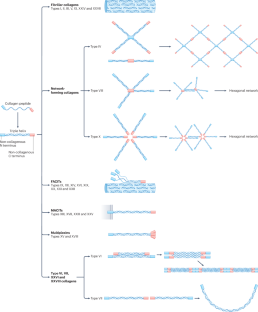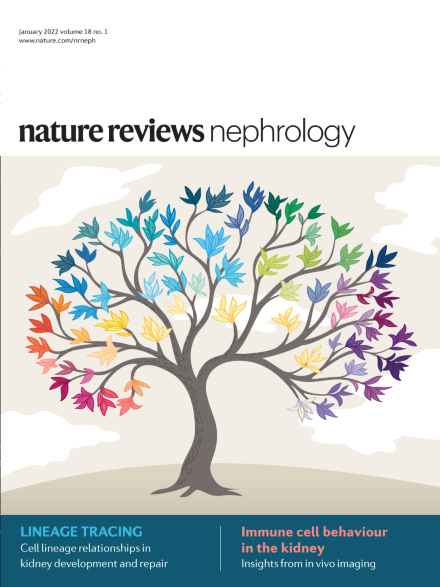Collagen formation, function and role in kidney disease
IF 28.6
1区 医学
Q1 UROLOGY & NEPHROLOGY
引用次数: 0
Abstract
Highly abundant in mammals, collagens define the organization of tissues and participate in cell signalling. Most of the 28 vertebrate collagens, with the exception of collagens VI, VII, XXVI and XXVIII, can be categorized into five subgroups: fibrillar collagens, network-forming collagens, fibril-associated collagens with interrupted triple helices, membrane-associated collagens with interrupted triple helices and multiple triple-helix domains with interruptions. Collagen peptides are synthesized from the ribosome and enter the rough endoplasmic reticulum, where they undergo numerous post-translational modifications. The collagen chains form triple helices that can be secreted to form a diverse array of supramolecular structures in the extracellular matrix. Collagens are ubiquitously expressed and have been linked to a broad spectrum of disorders, including genetic disorders with kidney phenotypes. They also have an important role in kidney fibrosis and mass spectrometry-based proteomic studies have improved understanding of the composition of fibrosis in kidney disease. A wide range of therapeutics are in development for collagen and kidney disorders, including genetic approaches, chaperone therapies, protein degradation strategies and anti-fibrotic therapies. Improved understanding of collagens and their role in disease is needed to facilitate the development of more specific treatments for collagen and kidney disorders. Collagens are ubiquitously expressed and have been linked to a broad spectrum of disorders. Here, the authors discuss collagen subtypes and provide a summary of collagen disorders, fibrotic process and therapies, with an emphasis on kidney diseases.


胶原蛋白的形成、功能和在肾病中的作用。
胶原在哺乳动物中含量很高,决定了组织的组织结构,并参与细胞信号的传递。除胶原蛋白 VI、VII、XXVI 和 XXVIII 外,大多数 28 种脊椎动物胶原蛋白可分为五个亚组:纤维状胶原蛋白、网络状胶原蛋白、三重螺旋中断的纤维相关胶原蛋白、三重螺旋中断的膜相关胶原蛋白和多个三重螺旋中断域。胶原蛋白肽从核糖体合成,进入粗面内质网,在那里经过许多翻译后修饰。胶原蛋白链形成三重螺旋,可分泌到细胞外基质中形成各种超分子结构。胶原蛋白广泛表达,与多种疾病有关,包括肾脏表型遗传疾病。它们在肾脏纤维化中也发挥着重要作用,基于质谱的蛋白质组学研究增进了人们对肾脏疾病纤维化组成的了解。目前正在开发多种治疗胶原蛋白和肾脏疾病的药物,包括基因疗法、伴侣疗法、蛋白质降解策略和抗纤维化疗法。我们需要进一步了解胶原蛋白及其在疾病中的作用,以促进针对胶原蛋白和肾脏疾病开发更具针对性的治疗方法。
本文章由计算机程序翻译,如有差异,请以英文原文为准。
求助全文
约1分钟内获得全文
求助全文
来源期刊

Nature Reviews Nephrology
医学-泌尿学与肾脏学
CiteScore
39.00
自引率
1.20%
发文量
127
审稿时长
6-12 weeks
期刊介绍:
Nature Reviews Nephrology aims to be the premier source of reviews and commentaries for the scientific communities it serves.
It strives to publish authoritative, accessible articles.
Articles are enhanced with clearly understandable figures, tables, and other display items.
Nature Reviews Nephrology publishes Research Highlights, News & Views, Comments, Reviews, Perspectives, and Consensus Statements.
The content is relevant to nephrologists and basic science researchers.
The broad scope of the journal ensures that the work reaches the widest possible audience.
 求助内容:
求助内容: 应助结果提醒方式:
应助结果提醒方式:


